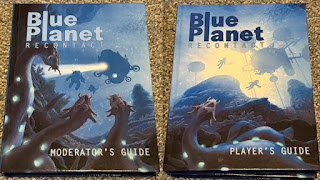 |
| The VTT at the session's end showing the mission planner |
Yesterday, I had the pleasure of running
Far Horizon, a Traveller/Cepheus Hard SF scenario using Zozer Games
Orbital 2100 setting (itself a prequel to
Hostile). The set-up is that the characters are the crew of a deep space explorer. the
Far Horizon, which has already been the first ship to reach Pluto, and has now been diverted to intercept a rogue planet that is wandering through the edges of the Kuiper Belt. The crew have already been in space for two years, and this will add an additional year before they get home, making the full mission around five years.
There's a crew of twelve, a mission of flight crew, engineers and mission specialists. They're all highly educated and cross trained. This means that practically you need to run the scenario with a degree of
troupe style play; the main difference to my past experience of this is that the characters are all full developed.
When I pitched the game on the Gaming Tavern, it was more popular than I expected, and I had enough people to fill two games. Once I pitched dates over the holiday, we ended up with six players, so I knew that this would likely push the AV on Roll20 to its limits.
I shared the characters details and tried to ensure that each player had a character that was likely to go on the away mission and another who would stay in the ship. I created a set of character portraits with artflow.ai just to give people a feel for the crew.
 |
| Montage of the crew, created with Artflow.ai |
After that it was pre-work putting the game on the VTT. Initially, I considered using PlayRole, but decided I wanted a bit more capability so stuck with Roll20 (which is a bit like comfortable shoes now having run Curse of Strahd and Shadows of Atlantis on the platform). There's a lot of information on the ship and the planet that I wanted to make easily available. However, that came with a challenge; there were several items that could only be populated once the characters had successfully completed scans and investigations. So this led to the need to build handouts that the players could amend.
The whole scenario is up against a clock, as the velocity of the rogue planet (named Tartarus to fit with the underworld theme of the mission to Pluto and Charon) means that the Far Horizon only has a 96-hour window to explore the planet. Stay any longer, and the voyage home will either be delayed or impossible. There is no hope for rescue. The light lag for a message to reach Earth is 5-hours. It will also take a similar amount of time for a message to get back, so there's a minimum of a ten-hour delay for any communication with Mission Control. It's analogous to sending memos by post rather than phoning someone.
So, twelve characters, ninety-six hours and a whole world to explore.
The scenario tries to address the challenge of this by having a list of key tasks and setting success criteria (or KPIs as one player put it). This had to be an editable form.
I was also concerned that we'd lose track of who was doing what, where and when. This was when I created the mission planner sheet. Effectively, it was a table with the characters across the top and the 96-hours broken into hour long chunks. It did feel a bit spreadsheet-like, and reminded me of planning engineering work during a shutdown when I used to be a project engineer, but it was very effective. Fortunately, I had several players who were minded that way and happy to work on the sheet.
The scenario's nature does seem to drive a very task and organisation focused approach rather than a character-led one. Team members are allocated to tasks and events ensue. I have tried to light encourage more getting into character, but I think that the nature of the game means that the players have switched into 'solve the problem' mode. That said, I'm enjoying it immensely as they puzzle out what's happening. We don't have the crew of the Prometheus here, we have a group of scientists, engineers and flight crew working together to explore deep space. It feels like a technical space mission, and I felt echoes of 2010 and Rendezvous with Rama.
Other decisions I made were to copy some of the key rules from
Cepheus Universal (which is based on Hostile) for environmental hazards onto the VTT to reference quickly. This helped immensely, as fatigue is a risk for the crew in this kind of mission, as are misfortunes involving space suits.
Roll20's AV was struggling despite one of the players not making it, with drop outs. I do know that I had issues with the connection on VirginMedia yesterday (it may be super-fast but it can be choppy). I think we will use Discord for Audio next session, so need to remind myself how that works.
So next session. I was optimistic that this would finish in a single session, but everyone seems keen to find out more. So far we're had a bumpy landing, hazards from ice, a failing space-suit and computer complications, but some quite significant discoveries which will change the face of human knowledge.
Finally a hat tip to Paul Elliott at Zozer Games; I had some queries about the scenario and he was kind enough to respond and sort them out.
31 December 2024





















